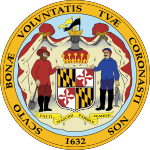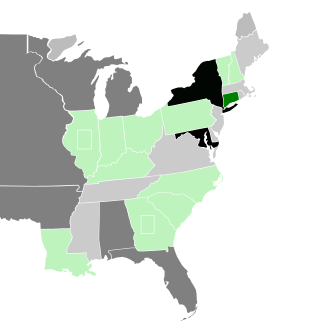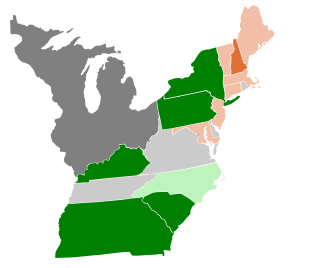A special election was held in Maryland's 2nd congressional district on February 1, 1826 to fill a vacancy caused by the resignation of Joseph Kent (A), who had been elected Governor of Maryland. [1]
| Elections in Maryland |
|---|
 |
A special election was held in Maryland's 2nd congressional district on February 1, 1826 to fill a vacancy caused by the resignation of Joseph Kent (A), who had been elected Governor of Maryland. [1]
| Candidate | Party | Votes [2] | Percent |
|---|---|---|---|
| John C. Weems | Jacksonian | 1,139 | 57.9% |
| William Woottan | Unknown | 827 | 42.1% |
Weems took his seat on February 7, 1826 [1]

The Maryland Senate, sometimes referred to as the Maryland State Senate, is the upper house of the General Assembly, the state legislature of the U.S. state of Maryland. Composed of 47 senators elected from an equal number of constituent single-member districts, the Senate is responsible, along with the Maryland House of Delegates, for passage of laws in Maryland, and for confirming executive appointments made by the Governor of Maryland.

Joseph Kent was an American politician and planter who was a United States Senator from Maryland, serving from 1833 until his death in 1837. He also served in the House of Representatives, representing the 2nd congressional district of Maryland from 1811 to 1815 and again from 1819 to 1826, and as the 19th Governor of Maryland from 1826 to 1829.

The 1826–27 United States House of Representatives elections were held on various dates in various states between July 3, 1826, and August 30, 1827. Each state set its own date for its elections to the House of Representatives before the first session of the 20th United States Congress convened on December 3, 1827. They occurred during John Quincy Adams's presidency. Elections were held for all 213 seats, representing 24 states.

William Daniel was an American politician from the state of Maryland. A lawyer, he was a noted prohibitionist and abolitionist. He served in both houses of the Maryland state legislature, first as a Whig, and later as a member of the American Party. Later, as a Republican, he was a member of the convention that wrote Maryland's constitution in 1864. He helped found the Maryland Temperance Alliance in 1872 and served as its president for twelve years. Daniel was the vice presidential nominee and running mate of John St. John on the Prohibition Party ticket in the presidential election of 1884. Placing third in the election that year, he continued his involvement with the cause of temperance until his death in 1897.

Maryland's 7th congressional district of the United States House of Representatives encompasses almost the entire city of Baltimore and some of Baltimore County. The district was created following the census of 1790, which gave Maryland one additional representative in the House. It was abolished in 1843 but was restored in 1950 as a west Baltimore district. It has been drawn as a majority-African American district since 1973. Democrat Kweisi Mfume is the current representative, winning a special election on April 28, 2020, to finish the term of Elijah Cummings, who died in October 2019. Mfume had previously held the seat from 1987 to 1996.

The 1806–07 United States Senate elections were held on various dates in various states. As these U.S. Senate elections were prior to the ratification of the Seventeenth Amendment in 1913, senators were chosen by state legislatures. Senators were elected over a wide range of time throughout 1806 and 1807, and a seat may have been filled months late or remained vacant due to legislative deadlock. In these elections, terms were up for the senators in Class 3.

The 1838–39 United States Senate elections were held on various dates in various states. As these U.S. Senate elections were prior to the ratification of the Seventeenth Amendment in 1913, senators were chosen by state legislatures. Senators were elected over a wide range of time throughout 1838 and 1839, and a seat may have been filled months late or remained vacant due to legislative deadlock. In these elections, terms were up for the senators in Class 1.

The 1818–19 United States Senate elections were held on various dates in various states. As these U.S. Senate elections were prior to the ratification of the Seventeenth Amendment in 1913, senators were chosen by state legislatures. Senators were elected over a wide range of time throughout 1818 and 1819, and a seat may have been filled months late or remained vacant due to legislative deadlock. In these elections, terms were up for the senators in Class 3.

The 1800–01 United States Senate elections were held on various dates in various states, coinciding with Thomas Jefferson being elected to the White House. As these U.S. Senate elections were prior to the ratification of the Seventeenth Amendment in 1913, senators were chosen by state legislatures. Senators were elected over a wide range of time throughout 1800 and 1801, and a seat may have been filled months late or remained vacant due to legislative deadlock. In these elections, terms were up for the senators in Class 3.

The 1796–97 United States Senate elections were held on various dates in various states. As these U.S. Senate elections were prior to the ratification of the Seventeenth Amendment in 1913, senators were chosen by state legislatures. Senators were elected over a wide range of time throughout 1796 and 1797, and a seat may have been filled months late or remained vacant due to legislative deadlock. In these elections, terms were up for the senators in Class 1.

The 1826–27 United States Senate elections were held on various dates in various states. As these U.S. Senate elections were prior to the ratification of the Seventeenth Amendment in 1913, senators were chosen by state legislatures. Senators were elected over a wide range of time throughout 1826 and 1827, and a seat may have been filled months late or remained vacant due to legislative deadlock. In these elections, terms were up for the senators in Class 1.

Pennsylvania elected its members October 10, 1826.

Maryland elected its members October 2, 1826.

Ohio elected its members October 10, 1826.

A special election was held in Ohio's 10th congressional district on October 10, 1826, the same day as the general elections for the 20th Congress, to fill a vacancy caused by the resignation of David Jennings (A) on May 25, 1826.

A special election was held in Virginia's 5th congressional district on January 21, 1826 to fill a vacancy caused by the resignation of John Randolph (J) on December 26, 1825, after being elected to the Senate.
The 1826 United States elections occurred in the middle of Democratic-Republican President John Quincy Adams's term. Members of the 20th United States Congress were chosen in this election. The election took place during a transitional period between the First Party System and the Second Party System. With the Federalist Party no longer active as a major political party, the major split in Congress was between supporters of Adams and supporters of Andrew Jackson, who Adams had defeated in the 1824 Presidential election.

The 2020 United States House of Representatives elections in Maryland was held on November 3, 2020, to elect the eight U.S. representatives from the state of Maryland, one from each of the state's eight congressional districts. The elections coincided with the 2020 U.S. presidential election, as well as other elections to the House of Representatives, elections to the United States Senate, and various state and local elections. On March 17, 2020, Governor Larry Hogan announced that the primary election would be postponed from April 28 to June 2 due to coronavirus concerns. On March 26, the Maryland Board of Elections met to consider whether in-person voting should be used for June's primary, and recommended that voting in June be mail-in only.

Robert Julian Ivey is an American politician serving as a member of the Maryland House of Delegates from District 47A in Prince George's County.

A special election was held on April 28, 2020, after a February 4, 2020 primary, to fill the remainder of the term in the United States House of Representatives for Maryland's 7th congressional district in the 116th U.S. Congress. Elijah Cummings, the incumbent representative, died in office on October 17, 2019.